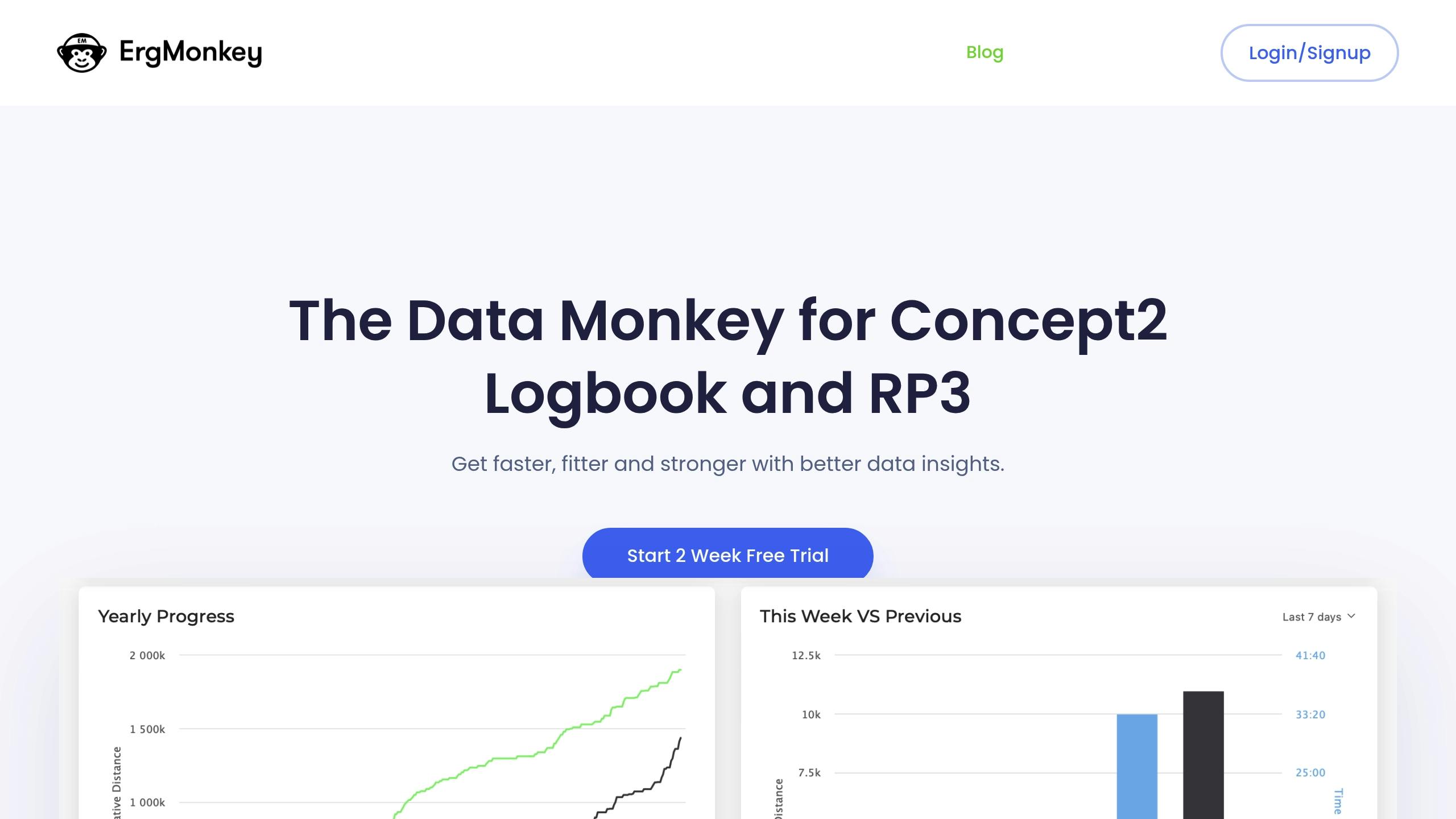04 Mar

Want to improve your rowing workouts? Combining heart rate and power data is the key. Heart rate shows how your body responds to exercise, while power measures your output in real time. Together, they help you train smarter and avoid overtraining. But these metrics don’t always align, and that can create confusion.
Key Points:
- Heart Rate: Tracks your body’s effort; influenced by factors like temperature, hydration, and fatigue.
- Power: Measures immediate effort in watts; reliable and unaffected by external factors.
- Common Issues: Misaligned zones, cardiac drift, and environmental effects can disrupt training plans.
- Solutions: Focus on power first, adjust heart rate zones, and use tools like ErgMonkey for better tracking.
Quick Tip:
Set power targets using your Functional Threshold Power (FTP) and use heart rate to monitor your body’s response. This approach ensures effective, balanced workouts.
Keep reading for practical strategies and tools to match these metrics and optimize your training.
Heart Rate Training for Rowing Machine – Heart Rate Zones and Workouts
Problems When Using Both Metrics
Using heart rate and power data together in rowing training can create challenges that may impact your workout results. Understanding these issues can help you fine-tune your approach for better outcomes. Let’s dive into how mismatched zones and missteps in training can disrupt your progress.
Zone Misalignment Issues
Heart rate and power zones often don’t match up. For example, heart rate is heavily influenced by temperature, even if power output stays the same. At 70°F (21°C), an athlete might have a heart rate of 160 BPM, but at 95°F (35°C), it could jump to 185 BPM – a difference of 25 BPM. Similarly, heart rate tends to be 5–10 BPM lower during indoor workouts compared to outdoor sessions, even when power output is consistent.
"HR is not actually measuring any kind of result, it is simply indicating how our body is reacting to the stress we are applying." – David W., Coach
These environmental factors throw off the alignment between heart rate and power zones, making it harder to synchronize your training efforts.
Training Level Mistakes
Misreading heart rate and power data can lead to errors in your training. For instance, cardiac drift – a gradual increase in heart rate – can cause heart rate to climb by 5–10 BPM during a one-hour session, and up to 15 BPM in workouts lasting over three hours, even though power output doesn’t change.
Here are some common factors that contribute to these mistakes:
| Factor | Impact on Training |
|---|---|
| Deconditioning | Higher heart rates at lower power outputs |
| Fatigue | Increased heart rate response to usual power |
| Time of Day | Variable heart rate despite steady power output |
| Recovery Status | Heart rate zones not aligning with power zones |
"Power is our output, Pace is an outcome, and HR is an indicator." – David W., Coach
For athletes who are deconditioned, heart rates can spike even at low power outputs, making heart rate data less reliable. Additionally, a mismatch between heart rate and power – known as aerobic decoupling – can signal poor aerobic fitness.
sbb-itb-1725142
Methods to Match Heart Rate with Power
When heart rate and power zones don’t align, adjusting your workout strategy can help you stay on track.
Power-First Measurement
Power output is the most dependable way to gauge workout intensity because it reacts immediately to changes in effort. To effectively use both heart rate and power, start by setting your power targets based on your Functional Threshold Power (FTP).
Here’s a breakdown of how different metrics perform during training:
| Metric | Response Time | Primary Use | Reliability Factor |
|---|---|---|---|
| Power Output | Instant | Workout intensity | High – directly tied to effort |
| Heart Rate | 90–120 seconds | Body’s response | Medium – influenced by various factors |
| RPE | Immediate | Perceived effort | Medium – subjective but still insightful |
Begin with power as your main guide, then use heart rate to fine-tune and account for daily variations. As the workout progresses, rely on real-time data to make adjustments.
Mid-Workout Corrections
Once you’ve established power targets, track both power and heart rate to ensure they’re working together. The relationship between these metrics can highlight aerobic decoupling – when heart rate rises while power remains steady or drops.
Here are a few common scenarios and how to handle them:
-
High heart rate compared to power
If your heart rate is unusually high for your power output, lower the power to bring the two metrics back in sync. -
Normal heart rate but lower power
This could point to fatigue or inadequate recovery. Shift to a recovery-focused effort and reassess your overall training load. -
Metrics are aligned
Stick with your planned workout and continue using power as your main reference.
For endurance workouts in zones 2–3, pay attention to your breathing. If breathing becomes labored despite hitting your target power, reduce intensity to ensure you stay in the aerobic training zone.
Tools for Better Metric Tracking
To address discrepancies in your workout metrics, it’s crucial to have properly configured equipment and tools for detailed analysis.
Rowing Machine Display Setup
Getting accurate heart rate and power data starts with setting up your display correctly. For Concept2 ergometers, adjust the screen to show both power output (watts) and heart rate simultaneously. Place heart rate data at the top of the screen so it’s easy to see during high-intensity sessions.
Here are some reliable heart rate monitor options:
| Heart Rate Monitor | Connectivity | Price | Ideal For |
|---|---|---|---|
| Polar H10 | ANT+ & Bluetooth | $99.95 | High accuracy |
| Garmin HRM-Dual | ANT+ & Bluetooth | $69.99 | Durability |
| Wahoo TRACKR | ANT+ & Bluetooth | $89.99 | Real-time tracking |
"The best heart rate monitors (HRMs) can be immensely beneficial if you know how to use the information they collect." – PCMag
Once your display is set up, pair it with tools that analyze your workout data for deeper insights.
ErgMonkey Analysis Features

ErgMonkey makes it easier to break down and understand your performance with features like:
- Heart rate zone analysis: Customize zones and track time spent in each.
- Power output trends: Compare workouts and monitor progress over time.
- Correlation insights: See how heart rate aligns with power output.
The Standard plan ($39.99/year) includes core analysis tools, while the Plus plan ($49.99/year) adds features like calendar-based workout planning.
For the most accurate heart rate readings, especially during interval training, chest strap monitors like the Polar H10 outperform optical sensors. Be sure to connect your monitor to both your rowing machine and tracking app to ensure consistent and reliable data.
Conclusion: Creating Your Data-Based Training Plan
Key Takeaways
Use power for immediate feedback during workouts and heart rate to understand how your body responds over time.
| Metric | Purpose | Response Time | Influencing Factors |
|---|---|---|---|
| Power | Measure intensity | Immediate | Based on effort |
| Heart Rate | Track body response | Gradual | Affected by temperature, hydration, and stress |
ErgMonkey provides tools to help you track and plan your workouts effectively. With these essentials in mind, you can incorporate them into your weekly training plan.
Steps to Begin
Here’s how you can get started:
-
Establish Your Baseline
- Use standard formulas and guidelines to determine your training zones.
- Complete a 20-minute trial to calculate your Functional Threshold Power (FTP).
-
Plan Your Weekly Training
- Schedule sessions across all five heart rate zones.
- Focus on power during workouts while using heart rate to monitor your physical response.
For a balanced routine:
- 2–3 high-intensity sessions (Zones 4–5)
- 2–3 endurance workouts (Zones 2–3)
- 1–2 recovery sessions (Zone 1)
"Heart rate zones and power zones enable your workouts to become more personalized, purposeful, and productive." – Stages Cycling
Leverage ErgMonkey’s workout comparison tools to track your progress over time. Adjust your training zones periodically based on your performance data to keep improving.


